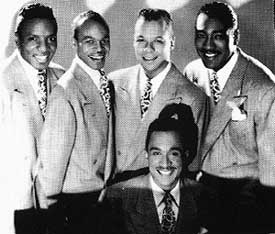 The Delta Rhythm Boys first sang together in 1934 while at Langston University in Oklahoma. Lee Gaines selected the singers, Elmaurice Miller as first tenor, Traverse Crawford as second tenor, Essie Atkins as base, & Lee was bass.
The Delta Rhythm Boys first sang together in 1934 while at Langston University in Oklahoma. Lee Gaines selected the singers, Elmaurice Miller as first tenor, Traverse Crawford as second tenor, Essie Atkins as base, & Lee was bass.
In 1936 they transferred to the Dillard University of New Orleans, & headed off to Louisiana. They were known at this time they were called the Frederick Hall Quintet, after their mentor at Dillard. They performed in many southern universities, sharping their sound.
They were unexpectedly hired for a gig in Buenos Ares that caused them to drop out of Dillard. They were by now calling themselves the Delta Rhythm Boys. The Buenos Ares gig went over so well that it led to a seven months tour of Argentina, Chile & Peru.
In 1938 they were already performing on Broadway. They released their first record in 1940 ("Chilly & Cold"/"Gimmie Some Skin"). In 1943 Essie Atkins was replaced by Kelsey Pharr as baritone, & in '44, Elmaurice Miller was replaced first by Clifford Holland & very soon after by Carl Jones.
Gaines, Pharr, Crawford & Jones would make up the quartet through the best years of the groups multi-decade existence. Although not officially disbanded until 1987 with the death of Lee Gaines, for all intent & purposes they ended in the 1970s, their recording career ended in 1961. Still, any way you measure it, The Delta Rhythm Boys had a long run.
Always billed as a vocal quartet, they often looked like a quintet because arranger & pianist Rene DeKnight seen in most but not all of their filmed numbers.
It was in 1941 they recorded "Dry Bones" & "Take the 'A' Train," one a gospel classic to reflect their down-home southern heritage, the other to reflect their thoroughgoing sophistication, & their recording career was off like a rocket, though their audience was still almost exclusivey in the black community. Their best known "Dry Bones" was recorded anew in 1947 at RCA & became the best known version.
By 1945 they'd been in a dozen films including Follow the Boys (1944) which had an enormous all-star cast. They were becoming household names even in white households, & finally had a cross-over hit with Duke Ellington's "Just A-Sittin' & A-Rockin'."
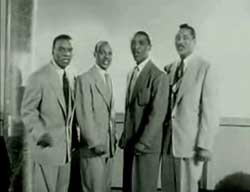 They did a visual jukebox soundie of their biggest hit & signature number Dry Bones (1945), which is often confused for a Snader telescription made a few years later.
They did a visual jukebox soundie of their biggest hit & signature number Dry Bones (1945), which is often confused for a Snader telescription made a few years later.
The Snader sometimes has the alternate title for the same song, Dem Bones (1951). The 1951 Snader shows the boys on a fairly plain stage with the corner of a curtain showing behind them.
The 1945 soundie is on a set tricked out to look like a private party in someone's apartment, with gorgeous gals sitting around, & the four harmonizing Delta Rhythm Boys standing behind a piano. It's an "almost acappela" piece, probably not cheating that someone provides a slow & simple percussive piano beat, & a justly popular song for every generation that has heard it.
Meanwhile out in the hallway, the janitor encounters a guy in a skeleton outfit dancing all around. The janitor pulls some fightened looks & skittish poses as the skeleton dances & dances. He then enters the apartment to try to get help from Delta Rhythm Boys, whose take a look out in the hall & see nothing.
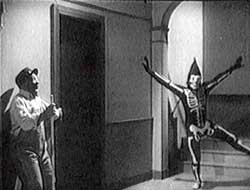 The half-step modulations that make "Dry Bones" so appealing originated with the Delta Rhythm Boys, & became the standard method of singing it only after their recordings of it. The half-step modulations that make "Dry Bones" so appealing originated with the Delta Rhythm Boys, & became the standard method of singing it only after their recordings of it.
The Snader film was incorporated into a music film pretending to be a night out at the Apollo Theater adding emcee Willie Bryant with a couple of his commedian pals, Nipsey Russell & Mantan Moreland. There's a half-hour version Showtime at the Apollo: Stars Over Harlem (1955) & a one-hour version Rhythm & Blues Review; aka, Variety at the Apollo (1955).
The 1945 soundie was similarly incorporated into Toot that Trumpet (1949), a fifteen minute film consisting of four soundies from 1943 to 1945 with new footage of an emcee, Monte Hawley.
The other soundies that make up that film are Louis Jordan's Jordan Jive (1944), Knock Me Out (1945) with Apus & Estrellita, & the title soundie, Francine Everett in Toot that Trumpet (1943) featuring also the tapdancing Sepia Steppers.
And just to add to the confusion, the Francine Everett soundie incorporated into the collection of four soundies is completely different from the Delta Rhythm Boys' soundie with only an exclamation point to distinguish the title Toot that Trumpet! (1941) by an acapella group a lot like the Delta Rhythm Boys & with the same initials, the Deep River Boys.
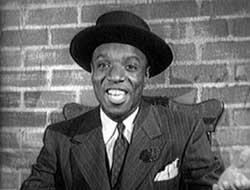 The abject & crossover popularity of "Dry Bones" lingers to this day for that percentage of the population who remembers the Delta Rhythm Boys, resulting in a lasting image of these guys as church lads who sang acapella, which was never their whole act at all. The abject & crossover popularity of "Dry Bones" lingers to this day for that percentage of the population who remembers the Delta Rhythm Boys, resulting in a lasting image of these guys as church lads who sang acapella, which was never their whole act at all.
Jack, You're Playin' the Game (1941) could as easily have been sung by Louis Jordan or some similarly flashy jump-jive performer. This is also a chance to see Elmaurice Miller in a lead vocal, as Carl Jones was not yet in the group as lead tenor.
Jordan & His Tympany Five was second only to the Mills Brothers in influencing the Delta Rhythm Boys. It was indicative of DRB's versatility that they could go from spiritual harmonizing on "Dry Bones" to veritable Mills Brothers impersonations on "Paper Doll" a ballad like 'what a Difference a Day Makes" to the jump-jazz of "Jack, You're Playin' the Game" or their cover of Louis Jordan's own "Is You Is Or Is You Ain't My Baby."
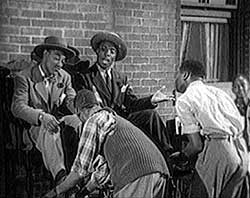 Two of the lads in nice suits are seated in shoeshine chairs in a street scene in Harlem as Jack, You're Playin' the Game opens. The two others are shining shoes. The youngest rhythm boy in finery begins the song: Two of the lads in nice suits are seated in shoeshine chairs in a street scene in Harlem as Jack, You're Playin' the Game opens. The two others are shining shoes. The youngest rhythm boy in finery begins the song:
"Now when you go out late & stay till dawn/ Your life is gay, yo'ure never forlorn/ Your togs are real snappy, you gotta be happy/ Cuz Jack, you're playin' the game."
Halfway through, the camera cuts away to a series of jivin' scenes of what it means to play the game. The two men who shine shoes are convinced by the song's sentiment & they give their shoeshine equipment to two young boys, buy some great clothes on credit, get some girlfriends & head out for the nightlife at Cafe Pom Pom.
The message might be dubious -- don't work hard, man, live the highlife running up debt -- although if its that or shining shoes into old age, dying in debt is gonna happen either way.
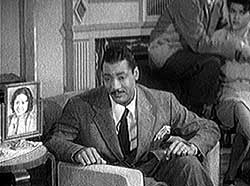 On the same set as for the 1945 soundie Dry Bones, , the Delta Rhythm Boys & their girlfriends or groupies are sitting around the apartment & the party definitely seems to have wound down, as everyone looks a bit depressed for the number Just a Sittin' & a Rockin' (1945).
On the same set as for the 1945 soundie Dry Bones, , the Delta Rhythm Boys & their girlfriends or groupies are sitting around the apartment & the party definitely seems to have wound down, as everyone looks a bit depressed for the number Just a Sittin' & a Rockin' (1945).
This number had reached number seventeen on the national charts that year, number three on the R&M chart. It's odd to realize it was their only cross-over hit, despite their familiarity to film-goers & their appearances on early television.
The lyrics run: "What's the good of having money/ When you haven't got your honey/ I don't go out walkin'/ I ain't for no talkin'/ My baby's done left me/ Just a sittin' & a rockin'."
Much more a swing tune than R&B, mellow & exceedingly sweet, they turn in a pleasant little love song. Toward the end, one of the gals decides to get up & tempt the lonely guy with a dance, while the other lads, with at least one girlfriend each, begin to regain their smiles.
Written by Duke Ellington, Lee Gaines & Billy Strayhorn, this song was covered by a lot of groups in its day & looked to be destined to the American Song Book as an immortal standard. It's since fallen away but remains a worthy choice.
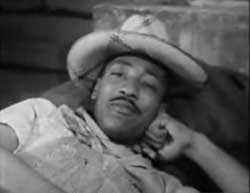 For I Dreamt I Dwelt in Harlem (1941), the Delta Rhythm Boys have been imposed upon to present the Glen Miller number while tricked out in straw hats & bib overalls while lazying around in a crowded country shack.
For I Dreamt I Dwelt in Harlem (1941), the Delta Rhythm Boys have been imposed upon to present the Glen Miller number while tricked out in straw hats & bib overalls while lazying around in a crowded country shack.
They've caved in to a crummy stereotype, but momentarily we see the lads in their "dream" clothes in Harlem.
When Hollywood used these stereotypes, it usually came off symbolically as meaning the southern rural life on the fringes of some plantation was easy & happy & lead a body to God, but those who fled north were soon brain-addled minions of Satan or at least always nostalgic for the planation.
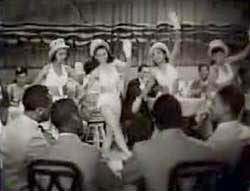 Fortunately this soundie doesn't go that far, & making it to Harlem is imagined as indeed joining the Renaissance. Fortunately this soundie doesn't go that far, & making it to Harlem is imagined as indeed joining the Renaissance.
There's a jump-cut from rural cabin to a cafe in Harlem, & the Delta Rhythm Boys dressed in white suits & black bow-ties are crowded around a little table with a couple drinks.
Although the dream is they're customers of the joint, they're also singing for the beauteous gals who are performing for the patrons, in white bathing suits, silver belts, & white top hats.
Momentarily a fancier dance couple rushes out to extend the power of the tap routine. It's all very colorful & appealing, a fairly big production to have launched in such a short-short film.
Then the lads leap up from their table to dance with the original four gals. Just before the dream ends, the rhythm boys are back at the shack in straw hats. It's quite the visual tale to go with a reasonably good rhythm & blues number & good dancing into the bargain.
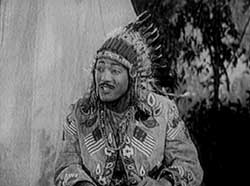 Wearing white jackets & standing by the piano, The Delta Rhythm Boys begin their boogie number Snoqualomie Jo Jo (1945) in fine harmony.
Wearing white jackets & standing by the piano, The Delta Rhythm Boys begin their boogie number Snoqualomie Jo Jo (1945) in fine harmony.
The title was apparently first mispelled by composer Joe Greene, as there's not really a second "O" in Snoqualmie. The lyrics are very silly, but it the sound is jumpin'.
On the second verse, the film jump-cuts away from the conservatively clad lads to a set where "Indians" -- four maidens & a feather-bonnetted chief who at second glance is bass delta rhythm boy Lee Gaines, in the title role of Snoqualomoe Joe.
The "Indians" are lounging around outside their teepee. A fifth Indian maiden comes high-steppin' through the scene. While Snoqualmie Jo Jo attempts to interest the dancing maiden in himself, her other boyfriend, a comic actor (same guy seen scared of the skeleton in the 1945 soundie for Dry Bones), shorter than herself, comes high-stepping by & takes her away.
Despite that the lyrics speak of "squaws," an offensive term unbeknownst to the composer, & are generally stereotyping, this is a sweet little boogie tune even so, & the black dancers dressed up as Indian maidens are kind of sexy. Kelsey in the chief's bonnet is wayyyy sexy, & that's not easily pulled off.
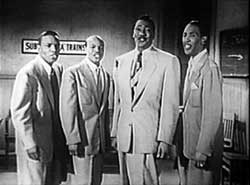 In another Snader telescription, Take the "A" Train (1951), the lads are standing in bulkily loose-taylored suits facing the camera.
In another Snader telescription, Take the "A" Train (1951), the lads are standing in bulkily loose-taylored suits facing the camera.
You can see this telescription spliced into one of the half-hour "Show Time at the Apollo" episodes of faked-concerts, issued as Showtime in Harlem (1955).
It's also included Sing Brother Sing (2005) which compiles the lion's share of soundies & telescriptions by the Mills Brothers & by the Delta Rhythm Boys. It by no means has all of DRB's short-short films, the visually more interesting soundie for "A" train for instance is missing, as is the great soundie for "I Dreamt I Dwelt in Harlem."
A sign has been affixed to the back wall & a chair placed under a chalkboard to give the imrpession of being in a subway station, for the very connection to Harlem the song is about.
They've arranged the Duke Ellington classic (written by Billy Strayhorn) beginning with bass lead from Lee, switching to tenor lead from Carl for another verse, & plenty of harmonizing throughout. Previously lacking the wonderful lyrics, the words were added by Lee Gaines himself, founding member & bass voice of the Delta Rhythm Boys.
Like nearly all Snaders, it's a live recording, to be cherished for the very fact of having been done live. It follows fairly closely the arrangement they first sang in 1941 when Essie Atkins & Elmaurice Miller were still in the group.
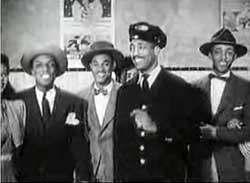 When that first recording was brand new, they made it into the soundie Take the "A" Train (1941), with Lee wearing a hat that makes him look like a police officer rather than a train conductor. It's filmed on a set tricked out with posters glued to concrete & train doors so it really looked like the subway. When that first recording was brand new, they made it into the soundie Take the "A" Train (1941), with Lee wearing a hat that makes him look like a police officer rather than a train conductor. It's filmed on a set tricked out with posters glued to concrete & train doors so it really looked like the subway.
It's a lip-sync performance as with all or nearly all soundies, but they're really acting out the scenario showing they could act.
One by one the other members of the group saunter into the frame, bringing girlfriends with them, nicely dressed since they're catching the "A" traiin up to Harlem to listen to some fine jazz.
More & more people arrive on the platform, everyone looking thrilled to be headed out for a night of fun: "Hurry! Get on, now it's comin'/ Listen! To those rails a strummin'/ All aboard. Get in the A train/ Soon, you will be on Sugar Street in Harlem."
As full-on harmony builds, the scene jump-cuts to a Harlem club, with everybody jive-walkin' into the room. There's a floorshow in progress, gals in short skirts & silly hats kicking a lot of leg.
This early soundie is a true classic, handsome singers singing beautifully, beautiful gals dancing well, a piece of pop music to this day recognized as one of the great swing tunes of the era, plus feature-film-worthy cinematography by Steve Shultz, all packed into less than three minutes.
copyright © by Paghat the Ratgirl
|
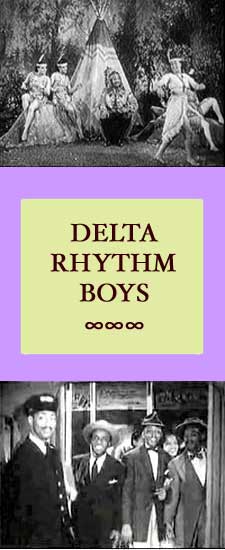


 The half-step modulations that make "Dry Bones" so appealing originated with the Delta Rhythm Boys, & became the standard method of singing it only after their recordings of it.
The half-step modulations that make "Dry Bones" so appealing originated with the Delta Rhythm Boys, & became the standard method of singing it only after their recordings of it.
 Two of the lads in nice suits are seated in shoeshine chairs in a street scene in Harlem as Jack, You're Playin' the Game opens. The two others are shining shoes. The youngest rhythm boy in finery begins the song:
Two of the lads in nice suits are seated in shoeshine chairs in a street scene in Harlem as Jack, You're Playin' the Game opens. The two others are shining shoes. The youngest rhythm boy in finery begins the song:

 Fortunately this soundie doesn't go that far, & making it to Harlem is imagined as indeed joining the Renaissance.
Fortunately this soundie doesn't go that far, & making it to Harlem is imagined as indeed joining the Renaissance.

